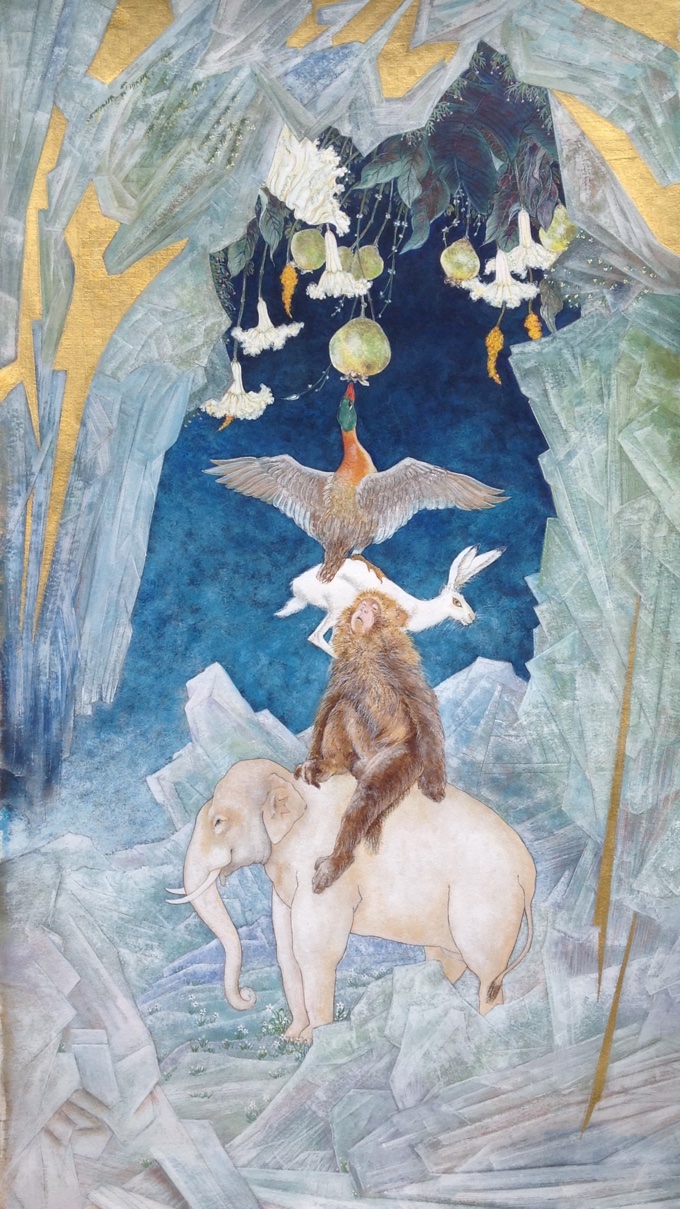The Story of the Four Harmonious Friends
We welcome back Roberta Mansell who has illustrated this story from the Jataka Tales, the previous life stories of the Buddha.

The Four Harmonious Friends - a Jataka Tale
Roberta Mansell
In former times in the jungles near Varanasi, a pheasant, a rabbit, a monkey, and an elephant lived in friendship and harmony. The four brothers declared that although their minds were harmonious, it was sad that in the world there was so little respect held by the young for the old. They decided to show respect for each other, according to the tradition of Dharma.
Having made this determination the four animals set out to make offerings and pay homage. The younger showed respect for the older by carrying the older on his back. Standing on each others’ backs in this way, the pheasant, rabbit, monkey and elephant reached the first limb of the banyan tree.
The pheasant taught the others how to follow the moral conduct of not taking lives, not taking what was not given, not speaking deceptive words, not committing sexual misconduct, and not taking intoxicants. Then each animal led similar types of animals to themselves on the path of morality. Happiness and comfort increased greatly in the world.
At that time, the king, his ministers, and the general population had the proud belief that the good times were due to their own merit. In order to determine who was responsible for the peaceful times they gathered together and asked a hermit to tell them the cause of their happiness. Through his clairvoyance the hermit explained that the countries’ wealth was not due to the power of any of the people but to the merits of the four animals in the forest who were keeping the five precepts of moral conduct and leading the other animals on that path. He advised them that they, too, should behave like these animals.
..............................
In former times in the jungles near Varanasi, a pheasant, a rabbit, a monkey, and an elephant lived in friendship and harmony. The four brothers declared that although their minds were harmonious, it was sad that in the world there was so little respect held by the young for the old. They decided to show respect for each other, according to the tradition of Dharma.
Having made this determination the four animals set out to make offerings and pay homage. The younger showed respect for the older by carrying the older on his back. Standing on each others’ backs in this way, the pheasant, rabbit, monkey and elephant reached the first limb of the nyän dro da (banyan tree).
The pheasant taught the others how to follow the moral conduct of not taking lives, not taking what was not given, not speaking deceptive words, not committing sexual misconduct, and not taking intoxicants. Then each animal led similar types of animals to themselves on the path of morality. Happiness and comfort increased greatly in the world.
At that time, the king, his ministers, and the general population had the proud belief that the good times were due to their own merit. In order to determine who was responsible for the peaceful times they gathered together and asked a hermit to tell them the cause of their happiness. Through his clairvoyance the hermit explained that the countries’ wealth was not due to the power of any of the people but to the merits of the four animals in the forest who were keeping the five precepts of moral conduct and leading the other animals on that path. He advised them that they, too, should behave like these animals.
Following this advice most of the people in that region began to keep the five precepts, and as a result, after they died, they were reborn in the deva realm.
It is said in the Vinaya teaching Dülwa rlung and the discourse Do de nä kyang rlung that the pheasant was an incarnation of the qualified destroyer gone beyond Shakyamuni Buddha and the others were disciples – the rabbit was Nyi gyä (Shariputra), the monkey was Päl na kyä (Maudgalyana) and the elephant was Kungawa (Ananda).
It is also said that wherever a picture of the four brothers is displayed, the 10 virtues will increase and the minds of all will become harmonious. There will be respect for elders and auspicious events will occur.
..............................
Test source: FPMT Website: https://fpmt.org/mandala/archives/mandala-for-2014/january/the-four-harmonious-friends/




